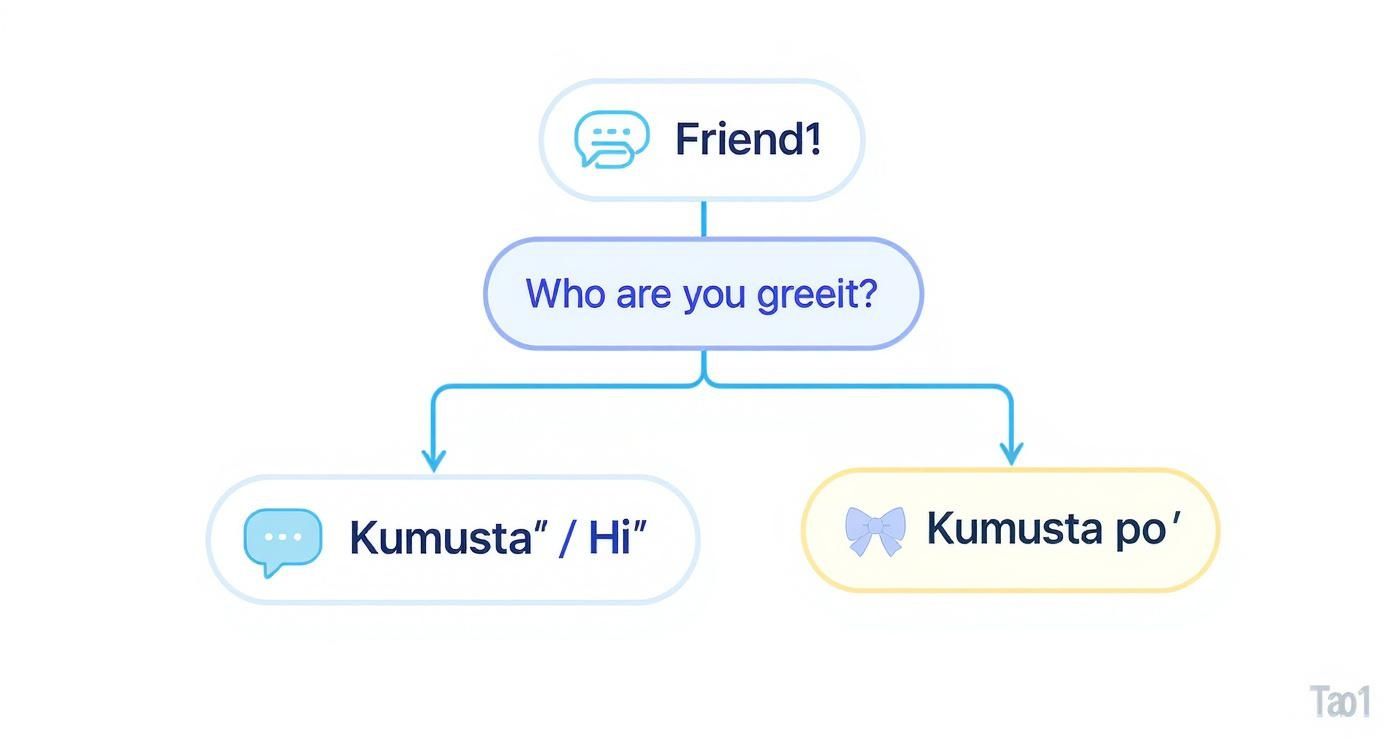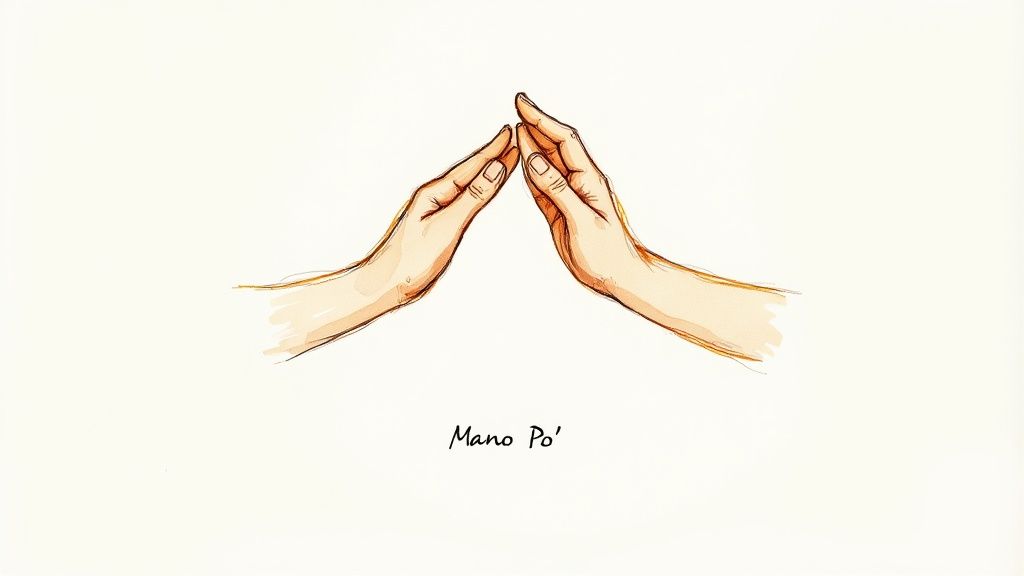how to say hello in tagalog: essential phrases for beginners
Learning to say hello in Tagalog is surprisingly straightforward. Your most essential greeting is Kumusta, which is the Filipino way of asking, 'How are you?'. But you'll also find that a simple 'Hi' or 'Hello' in English works just fine, especially in cities or when talking to younger Filipinos.
Your First Filipino Greetings
Getting started with Tagalog means getting a feel for a few key phrases that act as your entry ticket to friendly conversation. While Kumusta is the greeting you’ll use most often, knowing its nuances and when to use other phrases will help you sound much more natural. It's the difference between just saying hello and really connecting with someone.
One of the first things you'll notice is how Filipinos blend languages. This mix, known as "Taglish" (Tagalog + English), is everywhere. This actually makes things easier for learners because you can fall back on some English words as you're still finding your feet with new Tagalog vocabulary.
This linguistic adaptability is a big part of Filipino culture, even abroad. For instance, you'll hear Tagalog greetings all the time among the Filipino diaspora in places like Singapore, which helps maintain strong cultural connections. It's a beautiful way of keeping heritage alive, one conversation at a time. For a deeper look into where Tagalog is spoken globally, you can find more information on the number of Tagalog speakers worldwide.
Essential Tagalog Greetings at a Glance
To help you jump right in, here’s a quick-reference table with the most common greetings. Keep this handy as you start practicing—it's a great cheat sheet.
| Greeting | Pronunciation Guide | Context and Meaning |
|---|---|---|
| Kumusta | koo-MOOS-tah | The classic, all-purpose greeting. It works as "Hello" or "How are you?" and fits almost any situation you can think of. |
| Hi / Hello | (English) | Perfectly normal and widely used, especially in cities and with younger people. Don't feel shy about using it. |
| Mabuhay | mah-BOO-high | A very formal and celebratory greeting that means "long live." You'll hear this at official events or as a grand, warm welcome. |
Think of these as the foundational building blocks for your first interactions. Mastering them will give you the confidence to start a conversation anywhere.
Greeting with Respect Using Po and Opo
If you want to move past the basics of "Kumusta," you need to understand one of the most beautiful parts of Filipino culture: showing respect. This is where two tiny but incredibly important words come into play: po and opo. Think of them as more than just words; they're signals of politeness that instantly make your greetings feel warmer and more deferential.
Using "po" and "opo" isn't a grammar rule you can memorise and forget. It's a deeply ingrained cultural habit. You’ll always want to use these honorifics when speaking with:
- Elders, like your friend's lola (grandmother)
- People in positions of authority, such as a teacher or a boss
- Anyone you've just met or don't know well
So, instead of just asking an older person "Kumusta ka?" (How are you?), you’d soften it to "Kumusta po kayo?" That single word, po, completely changes the tone. It shows you recognise their age and status, and it’s a gesture that won’t go unnoticed.
When to Use Po and Opo
So what’s the difference? It's pretty straightforward once you get the hang of it.
Opo is simply the polite and respectful way to say "yes." It replaces the more casual "oo."
Po is a bit more flexible. It’s a particle you can sprinkle into your sentences to add a layer of politeness. It doesn’t have a one-to-one translation in English, but it works a bit like adding "Sir" or "Ma'am," only it's used much more frequently and naturally. You'll hear it in phrases like "Salamat po" (Thank you) or woven into greetings like "Magandang umaga po" (Good morning).
This little decision tree gives you a great visual on choosing the right greeting for the right person.
As you can see, who you're talking to really shapes the kind of greeting you should use in Tagalog.
Pro Tip: If you're ever unsure, just use "po." It's always better to come across as a little too polite than accidentally disrespectful. Filipinos are generally very welcoming and patient with language learners, but making an effort with "po" and "opo" is something they will always notice and appreciate. It’s a small detail that can make a huge difference in making a genuine connection.
Greetings For Different Times Of Day
While Kumusta is a great all-rounder, if you really want to connect with Filipinos, you'll want to greet them according to the time of day. Just like in English, there are specific phrases for morning, afternoon, and evening. It's a small detail, but it shows you're paying attention and making a real effort.
Using a time-specific greeting instantly adds a layer of warmth and cultural awareness to your interactions. Think of it as the difference between a generic "hello" and a more personal "Good morning!" when you walk into a local shop or meet someone for the first time.
You'll notice all these greetings start with the word Magandang, which beautifully translates to "good" or "beautiful." It’s a lovely little window into a culture that finds beauty in the different moments of the day.
Morning, Noon, And Night Phrases
Getting the hang of these is pretty simple. The main thing is to match the greeting to the right time, as Filipinos are quite specific about this.
- Magandang umaga (mah-gan-DANG oo-MA-ga) is your "Good morning." This one's perfect from when you wake up until about 11 AM.
- Magandang hapon (mah-gan-DANG ha-PON) means "Good afternoon." You’ll want to use this from around 1 PM until the sun starts to go down.
- Magandang gabi (mah-gan-DANG ga-BEE) translates to "Good evening." Once the sun has set, this is the greeting you'll use for the rest of the night.
There's also a more specific one you'll hear: Magandang tanghali (mah-gan-DANG tang-HAH-lee). This means "Good noon" and is used right around midday, usually between 11 AM and 1 PM.
Pro Tip: To show respect, especially to elders or people in positions of authority, just add "po" to the end of your greeting. "Magandang umaga po" is a wonderfully polite way to greet an older person in the morning.
To help you keep track, here's a quick guide to the time-specific greetings.
Time-Specific Tagalog Greetings
This table breaks down the essential greetings you'll need throughout the day.
| Tagalog Greeting | English Translation | Time of Day |
|---|---|---|
| Magandang umaga | Good morning | Dawn until ~11 AM |
| Magandang tanghali | Good noon | ~11 AM to 1 PM |
| Magandang hapon | Good afternoon | ~1 PM until sunset |
| Magandang gabi | Good evening | After sunset |
Learning these four phrases is a fantastic way to level up your Tagalog. It’s one of those small things that makes a big impression and shows you're genuinely interested in the culture.
Sounding Natural with Casual Greetings
While Kumusta is your go-to, all-purpose greeting, you'll quickly notice that daily chats with friends and colleagues have a completely different vibe. If you want to sound less like you're reading from a phrasebook and more like a local, you'll need to get comfortable with the more informal side of Tagalog.
The most common casual greeting you'll hear everywhere is 'Musta?'. It’s the relaxed, shortened version of Kumusta and it's perfect for friends, text messages, and social media. Dropping a 'Musta?' into conversation immediately shows you're comfortable and familiar with the person you're talking to.
Embracing Taglish in Everyday Chat
A huge part of modern Filipino conversation is the seamless blend of Tagalog and English, which everyone calls 'Taglish'. It’s not just slang; it's how the language is genuinely spoken today. You'll probably hear a simple 'Hi' or 'Hello' far more often than Kumusta, especially in bustling cities like Manila. This mixing of languages is also very common in Filipino communities abroad, including right here in Singapore.
The use of 'Hello' or 'Hi' alongside traditional Tagalog greetings is widespread among Filipinos in Singapore, reflecting a dynamic bilingual practice that helps maintain cultural identity in a multilingual environment. Discover more insights about language use in Singaporean communities.
This natural blend actually makes things a bit easier for learners. You don’t need to completely ditch English; weaving it in can make your speech sound more authentic. In fact, strengthening your conversational English can give you a great foundation for mastering this blended style. You might find our guide on how to speak English fluently useful for that.
Knowing which greeting to use and when is all about context. Here’s a quick breakdown to help you navigate social situations:
- 'Musta?': This is your best bet for friends, coworkers around your age, and pretty much anyone you know well.
- 'Hi' / 'Hello': A perfectly safe and neutral option for almost any informal setting. It’s universally understood.
- 'Hoy!' / 'Oy!': Be careful with this one! It’s the equivalent of shouting "Hey!" to get someone's attention. Use it only with your closest friends, as it can easily come across as rude otherwise.
Keeping the Conversation Going
https://www.youtube.com/embed/vkSpL29QYRE
Knowing how to say "hello" is a great start, but the magic really happens in what comes next. Turning a simple greeting into a proper conversation is how you build a real connection and show you’re genuinely interested in Filipino culture. It all begins with your reply.
When someone asks, “Kumusta ka?”, your classic, go-to response is, “Mabuti naman, salamat.” This is the perfect way to say, “I’m fine, thanks.” It's polite, friendly, and works in just about any situation you can think of.
But don't just leave it at that! A huge part of Filipino social etiquette is to return the question. After you've said you're doing well, just add, “Ikaw?” (And you?). This simple, one-word follow-up keeps the conversational ball rolling and shows you're just as interested in them.
Moving Beyond the Basics
Once the initial greetings are out of the way, you can dive a little deeper with some easy-to-remember questions. These phrases are your ticket from a brief exchange to a real chat, plus they’re a fantastic way to practise your listening skills.
- Saan ka pupunta? (Saan-kah-poo-POON-tah?) – This means "Where are you going?" In the Philippines, this is a very common and friendly question, not nosy at all. It's just a way of showing interest.
- Anong ginagawa mo? (Ah-NONG-gee-nah-gah-WAH-moh?) – Asking "What are you doing?" is another great way to engage with someone's day-to-day life.
Mastering these conversational connectors is a fundamental part of communication. As you build your Tagalog skills, you might also find it helpful to explore broader effective communication skills to enhance your interactions in any language.
Using these simple follow-up questions sends a clear signal: you're not just repeating phrases from a book, you're actually trying to connect. If you're looking for real-world practice, finding opportunities for a language exchange in Singapore is one of the best ways to build up your confidence with native speakers.
Understanding Filipino Greeting Etiquette
In the Philippines, learning how to say hello in Tagalog is really just the starting point. A greeting isn't simply a collection of words; it's a living, breathing expression of deep-seated cultural values like respect, family, and community. The way you carry yourself and the gestures you use often speak louder than the phrases you've memorised.
Your most powerful tool? A warm, genuine smile. It's the universal icebreaker, instantly signalling friendliness and good intentions. When you pair that with sincere eye contact, it tells the other person you're truly present and engaged in the moment.
This tight bond between language and cultural connection is powerful, even in highly multilingual societies. For example, research has shown that Filipinos in Singapore maintain a strong positive attitude towards using Tagalog, even though English is the primary language of business and education. This mirrors Singapore's broader identity, where over 70% of the population is bilingual, often speaking English alongside their mother tongue. You can discover more insights about Singapore's linguistic landscape on singstat.gov.sg. This knack for dual-language communication is a common thread in many multicultural hubs.
The Respectful Mano Po Gesture
One of the most beautiful and distinctive Filipino customs you'll encounter is the 'Mano Po'. This is a gesture of profound respect shown to elders—your grandparents, aunts, uncles, and even older family friends. It's a cornerstone of greeting etiquette.
Performing the mano is a simple, graceful act:
- You gently take the back of an elder's hand.
- Then, you lightly touch it to your forehead.
- As you do this, you say, "Mano po."
This gesture signifies that you are receiving a blessing from them, acknowledging their wisdom and place in the family and community. It's the physical embodiment of the respect that words like po and opo convey verbally.
Don't be shy about performing the mano if the opportunity arises. Elders are often deeply touched when they see others, especially non-Filipinos, making an effort to honour this tradition. It’s a small gesture that shows a huge appreciation for the culture.
Taking the time to understand and use these non-verbal cues will enrich your communication far beyond basic vocabulary. It’s a principle that holds true for any language you’re tackling; it’s an approach we find incredibly beneficial for those learning Bahasa Melayu in Singapore too. You're not just learning to speak; you're learning to connect on a much deeper, more meaningful level.
FAQs: Your Top Questions About Tagalog Greetings Answered
Once you start trying out these greetings in the real world, you'll probably have a few questions. Let's tackle some of the most common ones that pop up for new learners.
What If I Mess Up the Pronunciation?
This is a big one for many beginners. The fear of saying something wrong can be paralysing, but honestly, you shouldn't worry about it. Filipinos are incredibly warm and welcoming, and they genuinely appreciate it when foreigners make an effort to speak their language.
They'll almost always understand what you're trying to say from context. A genuine attempt with a smile goes a lot further than perfect pronunciation. If someone gently corrects you, see it as a good thing! It means they're happy you're learning and are willing to help you improve.
My Advice: Don't let the fear of mistakes hold you back. Your effort will be noticed and appreciated. Just dive in, give it a try, and you'll find people are more than happy to meet you halfway.
How Do I Know When to Be Formal?
Figuring out the formal versus casual dynamic can be tricky at first. Here’s a quick guide to two essential phrases to get you started.
- ‘Kumusta ka’: Think of this as your go-to informal "How are you?". It’s perfect when you're talking to one person you know well, like a friend, a classmate, or a colleague of a similar age.
- ‘Kumusta kayo’: This one is a bit more versatile. You'll use it when addressing a group of people (the plural "you"). It's also the polite, formal version for speaking to just one person you want to show respect to, such as an elder, a boss, or someone you've just met.
Can I Just Say ‘Hi’ or ‘Hello’ in English?
Yes, absolutely! It’s completely normal to use English greetings. English is one of the official languages of the Philippines, and you'll hear 'Hi' and 'Hello' everywhere, especially in cities and among the younger generation.
You won’t come across as rude or lazy for using English. In fact, in many everyday, casual situations, it's often the default greeting people use with each other.
At Spanish Council Singapore, we believe that mastering a language goes beyond vocabulary; it's about building cultural connections with confidence. Explore our engaging Spanish courses for all ages to start your own language journey. Learn more at https://spanish.sg.















